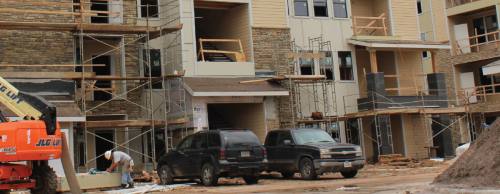 Spring and Klein have seen a considerable influx of multifamily developments in the last two years with even more apartments on the way as the region runs out of available land for development.
Spring and Klein have seen a considerable influx of multifamily developments in the last two years with even more apartments on the way as the region runs out of available land for development.
According to a 2014 study for Klein ISD by demographics firm Population & Survey Analysts, nearly 51 percent of all new residences built from 2013-14 were part of multifamily projects while more than half a dozen new high-end multifamily projects have opened from 2014-15 in the area.
“There has been a significant reversal of plans for commercial development with parcels now being altered to have multifamily complexes,” the PASA report states. “It is now felt there is a bigger demand for apartments than for strip shopping or office space or many of the smaller, undeveloped tracts.”
The trend is not expected to stop anytime soon as PASA projects nearly 41 percent of all homes built from 2014-24 will be multifamily residences.
Building upward
Many of the new apartment complexes are located on the north side of KISD’s boundaries at Spring Cypress Road or further north. One such complex—The Rise Apartments located at Stuebner Airline and Spring Cypress roads—had its first occupants move in May 26.
The 288-unit complex is the third multifamily development at the intersection managed by NOI Property Management, said Hunter Marfuggi, vice president of operations for NOI, which manages The Rise Apartments.
“Five years ago, I didn’t think a mid-rise [project] would develop there,” he said. “It’s across the street from mostly cows.”
Marfuggi said The Rise had 16 residents committed prior to the apartment complex officially opening. He said demand has been strong as new complexes usually see a strong demand from potential renters due to the exposure of the developments to motorists driving by on their daily commutes.
“We had a number of people while the site was still under construction trying to stop by and crawl under a link in the fence,” he said.
Not all new apartments in the region are popping up within KISD. Construction also finished in January at the first apartment complex in the Springwoods Village master-planned community, The Belvedere Springwoods Village, located within Spring ISD.
 Managed by Houston-based Martin Fein Investments, the complex is 55 percent pre-leased and about 40 percent leased, property manager Nathan Daniel Ward said. Although the development was slow to see occupants initially, Ward said demand has picked up as more ExxonMobil employees have made the transfer to the new campus.
Managed by Houston-based Martin Fein Investments, the complex is 55 percent pre-leased and about 40 percent leased, property manager Nathan Daniel Ward said. Although the development was slow to see occupants initially, Ward said demand has picked up as more ExxonMobil employees have made the transfer to the new campus.
“We’re still expecting more people to come in from off-site Exxon[Mobil] campuses,” he said. “It’s a little bit slower than [we] expected, but traffic has definitely increased.”
Fein Investment’s second apartment project in Springwoods Village, The Mark at CityPlace, is set to break ground this summer, Ward said. Located within CityPlace—the master-planned community’s town center—the high-end project will offer residents access to nearly 500,000 square feet of nearby retail.
Contributing factors
Community leaders said the influx of employees at ExxonMobil, Noble Energy and Southwestern Energy and the construction of the Grand Parkway have contributed to the proliferation of apartments in the region. But those are not the only factors driving demand, according to PASA and local property managers.
“The millenials are not really buying [single-family homes]. Renting is made so easy, so it’s kind of a no-brainer for people in the millennial age range.”
- Nathan Daniel Ward, property manager for The Belvedere Springwoods Village
The lack of available land in the area as KISD reaches build-out—or completion of the district—has led to higher density residential projects.
“As any school district matures, then the demand to allow more high-density housing becomes stronger, and usually the higher density residential developments are allowed at locations now deemed to be nonresidential sites,” the PASA report states.
Andy Teas, vice president for public affairs for the Houston Apartment Association, said it is not uncommon for areas like Spring and Klein to see more multifamily development with land prices increasing as apartments are a more efficient use of space. Teas said a shift in the economy with younger generations is also driving the demand.
“You don’t see people [going] to school and college, graduate, get a job and work there for 40 years,” Teas said. “People place a higher value on mobility than they used to. If they have a chance to get a job in Seattle [or] Boston, they want to be able to do that.”
Teas said more young professionals and young couples are choosing to rent rather than renting out of necessity.
“The millenials are not really buying [single-family homes],” Ward said. “Renting is made so easy, so it’s kind of a no-brainer for people in the millennial age range.”
Ward said the trend is noticeable in the complexes Fein Investments manages inside Loop 610. But the trend is less obvious at The Belvedere Springwoods Village where the average age of renters is 41. He said occupants are split between young professionals and middle-aged professionals with families.
The three complexes managed by NOI Property Management at Stuebner Airline and Spring Cypress roads have seen more families, Marfuggi said.
“We’re fortunate to have a family style demographic of residents,” he said. “It’s hard to achieve that. You get a lot of single [residents]. It’s hard to get a demographic that’s primarily families. It’s very neighborhood-like.”
The quality of the apartments being constructed today and improved amenities have also led to a demand for multifamily projects, Teas said. More complexes offer amenities and community services, such as valet trash service, resort-style pools and media rooms.
“The type of construction is really pretty amazing,” he said. “A lot of renters seem to care more about quality of amenities than they do square footage.”
Regional effects
Both local chamber of commerce presidents—Northwest Houston chamber President Barbara Thomason and Spring/Klein chamber President Myeshi Briley—said they have been pleased with the influx of multifamily projects in the region. However, with the population becoming more dense, Thomason and Briley expressed concerns about the effect of increased congestion on local thoroughfares.
“I think of course it’s going to bring more traffic,” Briley said.
Briley said local transportation entities have worked to improve roadways around the areas where new apartments have opened. In addition to segments F-1, F-2 and G of the Grand Parkway, which are expected to open by the end of the year, Harris County has completed or has plans to improve roadways in the area.
The county completed both the widening of Spring Stuebner Road from Kuykendahl Road to I-45 and the extension of Holzwarth Road—which now connects Springwoods Village south past Cypresswood Drive—at the end of 2014. Plans are also underway to expand Gosling Road from Spring Stuebner Road up to The Woodlands.
“[Transportation entities] are trying to look at some of those aspects when it comes to what will be some of the factors of all this growth,” Briley said.
Thomason said higher-density residential development can also put added pressure on school districts due to student growth. KISD has already planned for growth with the passage of its $498.1 million bond referendum May 9 that will help construct three new schools.
Neither Briley nor Thomason said they were concerned about the quality of the apartments being constructed. Thomason said the average 12-month lease for an apartment in the area is about $1,177 per month.
“I don’t think you can call that low-end housing,” Thomason said. “These are not your apartments of the 1970s that were built cheap. Certainly these are nicer, high-quality projects.”
Teas said crime within newer apartments being built across the Greater Houston area has not been a concern either in recent years.
“I think that’s a myth that comes from certain parts of Houston where [developers] built too many apartments in way too big of a hurry in the ’70s,” Teas said. “I don’t think you’re going to see anything like that again. The tax laws are so different now. You can’t really build apartments where there’s not a documentable demand for them.”





